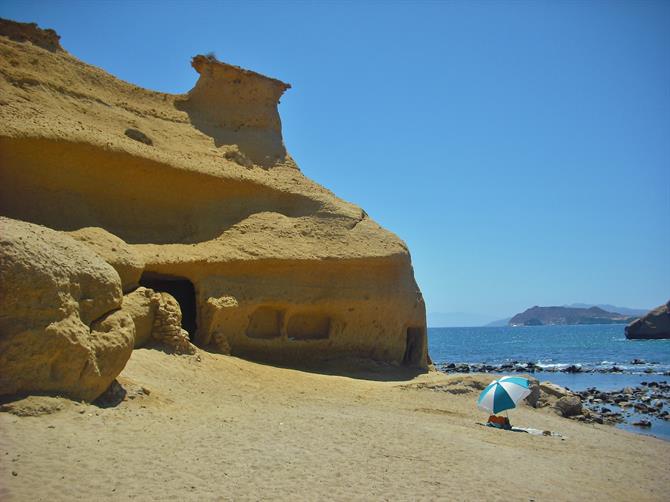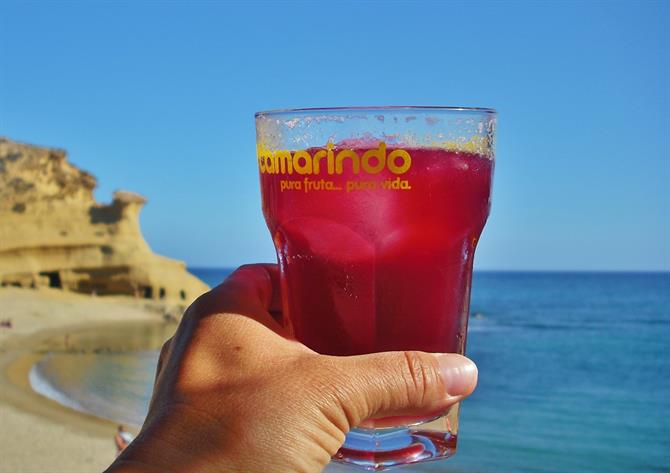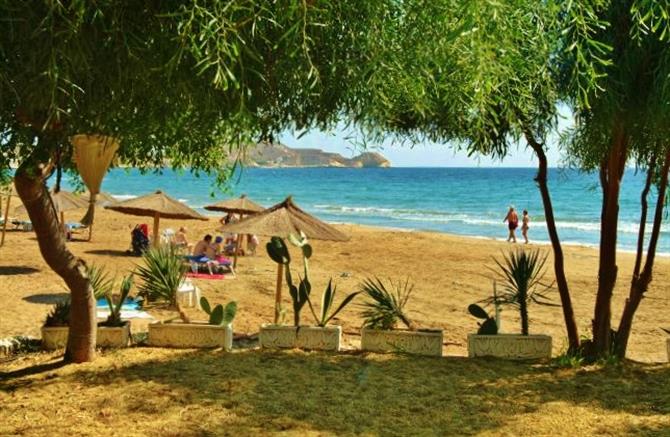The east Andalusian municipality of Pulpí is located on a remote part of the coast, which can be reached from the A-92 motorway by taking a particular detour. Magnificent sandy beaches, unspoilt coastline dotted with date palms and the bright blue colour of the Mediterranean makes this forgotten corner of Andalusia appear as if it has been painted.
The climate in Almeria is desert-like - there is a lack of green lush vegetation and a stark contrast between land and sea. Some of the warmest temperatures are recorded here and they prevail throughout the year.
Some of the greatest assets of the region are the magnificent bays between the town of Aguilas - which belongs to the Spanish province of Murcia - and the emerging resort of San Juan de los Terreros (Almería province), which is in the last corner of Andalusia. Here, wild stretches of beach and picturesque coves line up, making it a favourite spot for divers, snorkelers and kayakers.
From the beginning of the official Spanish summer holidays in July these beaches are indeed full, but there is still lots of space to run and play and plenty of room for privacy on the beach. There is also free parking for those who want to park up directly by the beach and listen to the waves crashing at night. Where else can you park for free today on the edge of the Mediterranean and have the whole sea to yourself?
A Landscape of Sea, Fossils and Petrified Sand Beaches
If anyone is interested in fossils and geology, you can analyse the exciting history of this coastal zone during a climb around the Playa los Cocedores. Here lie petrified sandbanks up to 20 metres high, which look as if they were frozen overnight.
In the rock you can find fossilised shells of all shapes and sizes. A mushroom-like rock head protrudes over the petrified sands at Cala Cocedores. You can climb up and overlook the bizarre landscape and get a magnificent view over the coast to Mojacar in the south and Aguilas to the north, the rocks there are always lit up by the sun.
The small rocky islands at Isla Terreros and Isla Negra are like sleeping whales in the ocean. Here, birds race around the rock which is home to many fish and squid which live beneath the surface.
Playa de los Cocedores - Family-Friendly Beach with Rock Caves

The bay of Playa de los Cocedores is best suited for children and people who like the quiet and still water. Access to the beach is located between two rocks. The trademark features of this beach are the caves that have been beaten into the rock here, which for centuries fishermen and farmers used as shelter.
The water is wonderfully clear and the underwater world is still intact - ideal for snorkelers who want to get lost among the rocks in between colourful schools of fish.
Slightly above the beach is an idyllic, family-run Chiringuito called "Los Cocedores" where you can taste one of the best iced Tinto de Veranos (red wine and lemonade) around. There is always a fine selection of typical Andalusian tapas available like boquerones (little fried fish), tortillas, salads or albondigas (meatballs in tomato sauce).

Playa la Carolina - A Caribbean Feeling on the Mediterranean
Just a few steps from the small bay is the popular beach Playa la Carolina, it has the finest golden sand and crystal clear water. A parking lot is located above the beach and you can easily make the journey from car to beach with an umbrella and deck chair, down the wooden stairs and onto the long, beautiful beach.
There is a second Chiringuito, where you can get coffee, cold drinks, ice cream and snacks during the summer. Experience this, with some of the best quality bathing around at San Juan de los Terreros.
The views from the beach on Isla de Terreros are fantastic. The Pichirichi is a strange battered protrusion at San Juan, from which you can jump into the gorgeous water. Legend has it that the rock is actually the back of a petrified whale, but time, wind and weather have smoothed the fossil. In any case, the mythical Pichirichi is the landmark of the small beach town of San Juan de los Terreros (Pulpi province). Since 2012, the rock also has had wheelchair access.
Blue Flag Beach Resort
San Juan de los Terreros was once a fishing village but is now being transformed into a large resort. It is definitely worth a trip to this village because the beaches are amazing. The three city beaches - Playa Mar Rabiosa, Playa Mar Serena and Playa El Calypso were awarded Blue Flags in 2014, as they provide some of the very best bathing in the area. Both land and sea are clean and clear.
Blue Flags are not only for cleanliness and quality, but also for environmental protection. Incidentally, including these three new excellent beaches at Pulpi, there is now a total of 96 Andalusian beaches which have blue flags. The Spanish region is one of the most popular destinations for tourists on the mainland and boasts many kilometers of coastline.
Locals drive here from the hot mainland to enjoy a cool weekend by the sea with the whole family.
Free Parking, Swimming and Cheap Tapas
If you fancy a swim at San Juan, park your car in the big free carpark behind the coastal road A-332 in Las Salinas and walk along the promenade to the beach on foot. The walk is flat and takes just a few minutes.
Playa Mar Serena is the most beautiful beach for children and those who love shallow, crystal clear, calm sea water. Serena means "quiet" in Spanish, so you can always guarantee a peaceful and relaxing day, free from wind and bothers. Playa Serena is 100 metres long and 35 metres wide and has clean toilets, showers and barrier-free access to the sea for wheelchairs.

The popular beach Playa El Calypso is 250m long and 20m wide. It can be a bit crowded in the summer and so the best hours to visit would be in the morning when it is a little quieter. Spaniards have nothing against narrowness and lively beach life and pop up their party tents, umbrellas and chairs close together, creating a large, shady party zone.
Luckily, there are plenty of quiet corners where you can retreat and watch the hustle and bustle.
